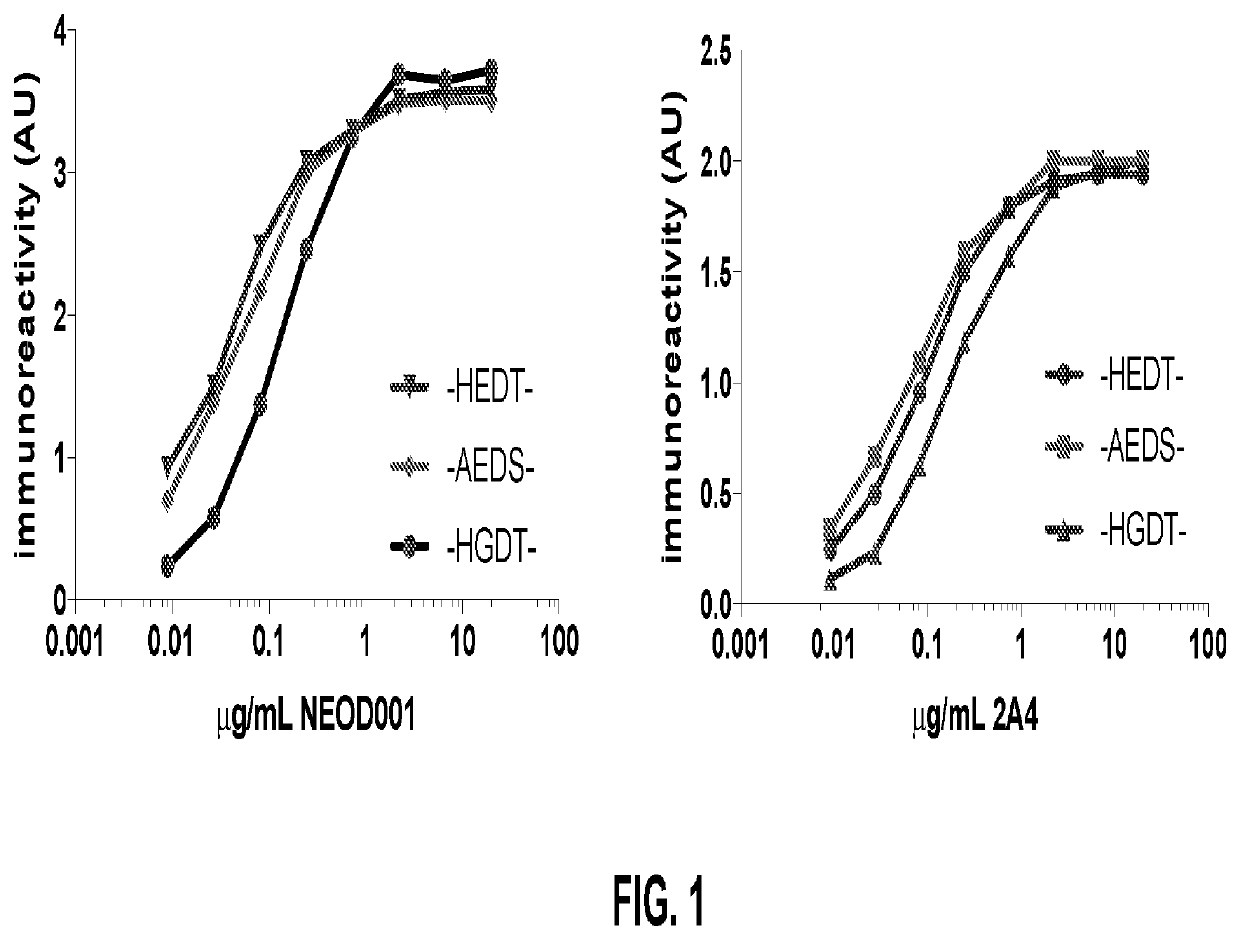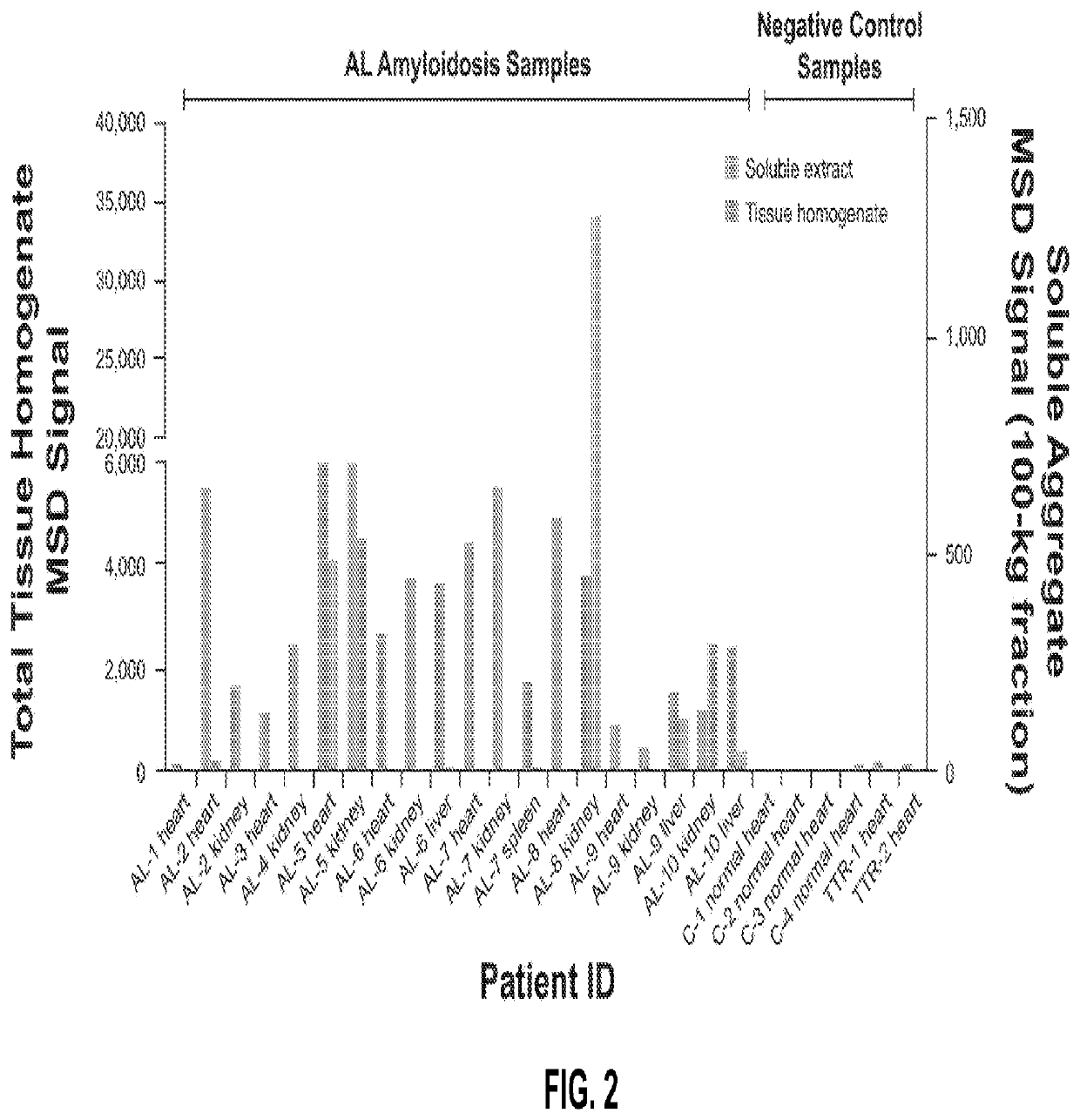Treatment and Prophylaxis of Amyloidosis
- Summary
- Abstract
- Description
- Claims
- Application Information
AI Technical Summary
Benefits of technology
Problems solved by technology
Method used
Image
Examples
example 1
[0062]Bioinformatic Analysis of AL-Associated LC Sequences
[0063]The occurrence of different amino acids at position 81 and 82 across the entire human VK and VL germ line gene repertoire was determined by applying the Kabat numbering system to the LC sequences from ImMunoGeneTics (IMGT) database and amino acid sequence alignment using the MegAlign tool of the LaserGene DNA software.
[0064]The frequency of gene subtypes and alleles that are prevalent in patients with AL amyloidosis was determined by bioinformatics analysis of the published LC sequences in ALBase (Boston University) and various publications. Kabat numbering system was applied and IMGT / DomainGapAlign software tool was used for gene subtype and allele identification.
[0065]The predominant amino acid sequence at positions 81 and 82 identified by this bioinformatics analysis was -ED-, which was identified in 77.89% of light chains analyzed. -GD- was the second most frequent sequence, though much less common than -ED-, being ...
example 2
[0066]Immunoreactivity of NEOD001 and 2A4 Against X1EDX2 and X1GDX2 Peptides
[0067]ELISA plates were coated with peptides having the amino acid sequence HEDT (SEQ ID NO: 19), AEDS (SEQ ID NO: 20), or HGDT (SEQ ID NO: 21), blocked, and assayed with either NEOD001 (an antibody with a light chain having the amino sequence set forth as SEQ ID NO: 13 and a heavy chain having the amino acid sequence set forth as SEQ ID NO: 14) or 2A4 (ATCC Accession Number 9662), as indicated. After washing, appropriate horseradish peroxidase-conjugated secondary antibodies were applied. The plate was then washed and developed with o-phenylenediamene, and absorbance was read at 490 nm.
[0068]As shown in FIG. 1, both NEOD001 and 2A4 bind all three peptides. Thus, these antibodies bind both X1EDX2 and X1GDX2 amino acid sequences present in immunoglobulin light chains.
example 3
[0069]Determination of Light Chain Subtypes of AL Amyloidosis Tissue Samples Bound by NEOD001 and 2A4
[0070]19 fresh-frozen samples from AL patients were processed to soluble and insoluble samples and 2A4 binding was assessed in an electrochemiluminescence (ECL) immunoassay. The results are shown in FIG. 2. Subsequently, laser capture microdissection mass spectrometry (LCM-MS) was performed on the samples. Samples were stained with Congo Red to localize amyloid deposits, and deposits were excised by laser capture microdissection. Isolated deposits were deparaffinized and solubilized before analysis and sequencing by LCM-MS. The epitope residues were directly determined by LCM-MS. The results are presented in Table 1.
TABLE 1LCM-MS and sequence analysis of AL amyloidosis tissue samplesSample IDLC geneEpitope residuesAL-1NDNot determinedAL-2LV1-44-ED-AL-3NDNot determinedAL-4KV4-1-ED-AL-5LV6-57-ED-AL-6LV6-57-ED-AL-7LV2-18-ED-AL-8LV3-21-GD-AL-9NDNot determinedAL-10LV2-14-ED-
[0071]Interest...
PUM
| Property | Measurement | Unit |
|---|---|---|
| Fraction | aaaaa | aaaaa |
| Percent by mass | aaaaa | aaaaa |
| Molar density | aaaaa | aaaaa |
Abstract
Description
Claims
Application Information
 Login to View More
Login to View More - R&D
- Intellectual Property
- Life Sciences
- Materials
- Tech Scout
- Unparalleled Data Quality
- Higher Quality Content
- 60% Fewer Hallucinations
Browse by: Latest US Patents, China's latest patents, Technical Efficacy Thesaurus, Application Domain, Technology Topic, Popular Technical Reports.
© 2025 PatSnap. All rights reserved.Legal|Privacy policy|Modern Slavery Act Transparency Statement|Sitemap|About US| Contact US: help@patsnap.com


